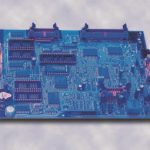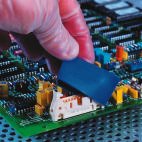In this praxis-based synopsis on conformal coating, we explain how a user can successfully implement and monitor this process technology in 10 steps on the shop floor.
Conformal coatings are used to shield board assemblies that are used in harsh operating environments. Their use is typically employed for safety-critical applications and for those who have to be protected from environmental influences. The coatings form a thin (nominally 50±25µm thick) plastic film on assemblies. The film acts as a barrier against environmental damage from elements such as moisture, frost or humidity, from extreme temperature changes and other conditions, from aggressive chemicals, vapors, liquids or salt sprays.
More recently, conformal coatings have been applied to more mundane products as a way of enhancing reliability. Establishing a conformal coating process is relatively simple, providing certain rules are obeyed.
1) Design the PCBs for conformal coating
If a decision to use conformal coating is made as part of the product specification – for example it is known that an assembly will be used in a harsh operating environment – the designer can take steps to ease the coating process. Unfortunately, designers rarely, if ever, take into account thefact that the board will be coated during manufacture.
If this situation is addressed, and the board is designed for conformal coating from the outset, process cost savings can be made. The key design requirement is that components that shouldn’t be coated (such as connectors, trimmers, fuses and pre-sets) should be put at one edge of a board. This allows the assembly to be dip coated using automated in-line methods, and eliminates the need for masking. Automating the coating process makes it relatively simple and inexpensive for a manufacturer to process volumes (typically under 0.1 euro per board with dipping). This is the approach used, for example, by most automotive electronics manufacturers.
2) Match the coating to board application
There is no shortage of alternative conformal coatings. It must be appreciated, however, that there is also no perfect solution. The difficulty is in selecting the best type for an assembly. The environment in which a board is designed to operate, the cost of the coating, and how easy it is to apply and remove in the event of rework, primarily governs this choice. Each type of coating has different strengths and weaknesses. The performance of each represents a working trade-off. For example, improved thermal resistance or a wide temperature operating range may be gained at the expense of poorer chemical resistance.
Additionally, no coating can be regarded as a totally impermeable layer. Although many coatings are engineered to offer high levels of environmental protection, none can withstand extremes such as extended aggressive chemical attack or prolonged immersion in water.
3) Select the best type of coating
Coatings are usually supplied as liquids with the coating material itself suspended within a carrier medium (traditionally a solvent). There are essentially five main types: acrylics, polyurethanes (or urethanes), epoxies, silicones and UV-curables. Here, comments on all aspects of performance are relative in comparison with other material types and should not be taken as absolute characteristics. In addition, recent advances in coating material and polymer technology are narrowing the performance gap between different coatings.
Acrylics provide high humidity resistance, have relatively high dielectric performance (good impedance), selective chemical resistance, good temperature resistance and are fungus resistant. They are easy to apply, have a long pot life, cure rapidly, and can be quickly removed during rework(with suitable solvents, or for spot repairs by soldering directly through them). There is little heat generation or shrinkage (limiting excessive mechanical stress upon components and joints).
Urethane coatings have excellent chemical resistance while offering good moisture, temperature and dielectric characteristics. Their chemical resistance, however, makes rework difficult and expensive, demanding the use of special stripper compounds. While polyurethanes can be soldered through, there is usually a brownish residue which affects the aesthetics of an assembly. Curing time is average.
Epoxy coatings have excellent resistance to abrasion and chemical resistance, but poorer moisture and dielectric characteristics. Cure time is average, but they are virtually impossible to remove chemically for rework, due to the epoxy-based materials such as the substrate itself and plastics used in component packages that could be damaged by the application of any epoxy-attacking stripper. The only effective way to repair a board or replace a component is to burn through the epoxy coating with a knife or soldering iron. In addition, when most epoxies are applied a‘buffer’ material must be used around fragile components to prevent damage that can be caused by the coating shrinkage during cure. A very short shelf life further hinders application.
Silicones offer high temperature, moisture and dielectric resistance, but limited chemical resilience. A very low surface tension aids penetration into every part of an assembly and imparts flexibility. Like epoxies, however, they are difficult to rework. Their primary use is in high temperature applications up to around +200ºC, making them desirable for assemblies with, for instance, large heat dissipating devices.
Ultra-violet (UV) light curable coatings are becoming much less popular. However, they offer the fastest curing time, hardening in seconds rather than hours. They have good moisture, dielectric and temperature resistance and high chemical resistance. Application is made more difficult because component shadowing during exposure to UV light inhibits proper curing. This can be resolved by the use of a catalyst, although this introduces further drawbacks because of the need to deal with a two-part system.
4) Consider environmentally friendly conformal coatings
Most traditional conformal coatings are solvent-based, and as a result their industrial application can produce harmful solvent and VOC emissions. This raises a range of health and safety issues as they are classed as hazardous chemicals that need to be handled according to strict guidelines, require fume extraction, and can be highly flammable and volatile. The primary advantage of water-based coatings is their extended temperature performance (up to +200ºC and beyond).
As a result of the inevitable environmental concern, European industry has already moved away from traditional solvent-laden formulations towards low-solvent types. This trend will continue unabated with the large-scale introduction of water-based alternatives. These have been developed to such an extent that they now share similar behavior and performance characteristics with traditional solvent-based products and also cure rapidly.
Switching to a water-based coating may be an environmentally friendly action, but it isn’t easy and there are many potential pitfalls and drawbacks that have to be overcome. No water-based coating is a direct and easy drop-in replacement to the traditional offerings. Collaboration between Concoat and Humiseal has resulted in a ten-year evaluation and development program for water-based coatings. Although an early pioneer, they made a major breakthrough which lead to the recent introduction of an entirely new range of coatings (Humiseal 1H20). These coatings are fundamentally different to solvent-based materials in that they are emulsions and as such do not lend themselves to simple mixing. They are available in different versions to suit the application methods of spraying, dipping and automated selective processing.
5) Compare costs
When comparing costs, consider the relative solids content between alternative suppliers’ products. Coatings with higher solids content may appear more expensive, but less material is required to cover an assembly with a sufficient coating thickness. The best way to compare costs is to divide the unit liter cost of a material by its percentage solids content to get a cost-per-percentage-solids figure.
For example, a 1l tin of 20% solids material costing euro 25 will have a euro 1.25 per percentage solids ratio. A 1l tin of 40% solids material costing euro 35 will have a euro 0.875 per percentage solids ratio. Thus the latter actually works out more cost-effective despite the cost per liter being higher.
6) Test the board surface for contamination that could effect reliability
No conformal coating provides an impermeable barrier. Moisture can penetrate and cause some degree of degradation. This can be made worse if moisture penetration reacts with residues left on the board after assembly. The conformal coating, while acting as a barrier against external contaminants, can also seal in remains that are on the board at the time of coating. This can be a greater problem if the board hasn’t been subject to cleaning.
It is therefore vital to perform long term accelerated life testing and surface-insulation-resistance (SIR) analysis on the assembly (produced under factory conditions, conformally coated and de-masked). This will help to ensure that there are no electrochemical compatibility issues between various chemistries and materials (solder resist, flux, adhesives and cleaning agents) that could cause unexpected long-term reliability problems.
Board residues are often salt that can dissolve repeatedly through the penetration of moisture. This will induce an osmotic pressure (pumpingaction) which can compromise the protectiveabilities of the coating and in the most extreme cases cause voids and bubbles in the coating. When considering any new coating material, it is important to consider its effects on the long-term.
Testing may indicate the need for board cleaning to remove contaminants. This procedure can be simplified by using materials that are guaranteed to be compatible. Concoat, for example, offers a continually expanding range (Synergie) that includes solder masks, solder resists, fluxes and wires. These all offer full compatibility between various manufacturing processes to enhance safety, production efficiency and reliability.
7) Select the coating process
There are three main ways of applying a conformal coating in production: dipping, manual spraying and automated (selective) spraying. Dipping an assembly into a bath of coating material is usually the most efficient method and promotes full penetration beneath components on both sides simultaneously and eliminates the need for any form of masking. Plenty of automated equipment is available for this purpose. Assemblies must be dipped vertically (never horizontally) to ensure coating uniformity. Typical recommended immersion speeds are between 15 to 30cm/min to allow sufficient time for the coating to displace the air surrounding components and to avoid air bubble entrapment. The assembly should be left in the bath until all bubbling has stopped. The withdrawal speed must be slower than the cascade effect of the coating material being used (typically 2.5 to 15cm/min) so as to give a homogenous film covering the entire assembly. The dipping method does demand that a board is designed to be conformally coated this way. Usually an assembly will feature devices that must be protected from the conformal coating distributed across the board. These must be masked, and then the board is coated with either hand or automated spray techniques. This is a more time-consuming operation than dipping (de-masking can be considered a rework task) and therefore more expensive, but it is probably the most common application method.
Selective automated spraying is the best option, as hand spraying is prone to all the classic inaccuracies and inconsistencies of any manual process. Despite being an in-line procedure, it is relatively slow, demands full fume extraction, and can suffer from shadowing effects and lack of penetration under components. Although spraying produces an aesthetically better product, it can require several coats to ensure adequate coverage. In any case, complex shapes and forms (such as cubic devices) are a problem and cannot be effectively coated other than by dipping. Automated spraying machines apply the coating according to a pre-programmed profile via an array of nozzles or spray heads. Selective spraying does not eliminate the need for masking, but does help minimize it. (Vias on double-sided boards, for example, may lead to coating of underside components that need to be protected and should therefore be masked.)
8) Remove the masking
When selecting a masking material, ensure that it can easily be removed after the conformal coating application. Most materials can simply be peeled away manually. It is important, however, for this to be done in a single, non-flaking movement in which the masking material does not break-up into small fragments. Tiny amounts of residue that remain on a board surface should be inert and not introduce contamination that could potentially lead to long-term reliability issues.
9) Inspect the coated assembly
Any conformal coating process should be visually inspected under a UV-microscope. All coatings contain a UV-trace that glows with a bright blue luminescence under this light to make it easy to detect coated and uncoated areas. With experience, operators can use the degree of luminescence as a measure of both presence and volume of coating at different locations across a board’s surface. There is a range of dedicated products available for this purpose. In collaboration with Vision Engineering, Concoat has developed an inspection tool specifically designed to make this procedure as easy and effective as possible. It is also important to inspect boards after rework to ensure that any re-application of coating material doesn’t end up on the inside or underside of devices that should not be coated. One difficulty of this, however, is that the UV-tracer has low surface energy. This means it can sometimes glow – suggesting that there is a coating there – at a point on a board surface, when in reality the area remains uncoated. Operator training and experience can usually overcome this difficulty.
10) Select knowledgeable vendor
Choosing the right conformal coating and application process can be difficult and time-consuming. It therefore pays to work with a vendor that has a wealth of experience in solving those specific problems and can give advice on reliability standards. Establishing an effective coating process therefore isn’t quite as simple as may initially seem. But time and effort invested into getting it right will be amply rewarded by the eliminationof board failures in the field. And this is the most expensive, and in safety critical applications, life-threatening problem a company will ever experience.
ZUSAMMENFASSUNG
Mit selektiv aufgebrachten Überzügen aus unter-schiedlichen Materialien schützt man Baugruppen vor Umwelteinflüssen aller Art. Dort, wo es auf höchste Langzeitzuverlässigkeit ankommt, sind solche Schutzüberzüge unverzichtbar. In zehn Schritten schildern wir die Implementierung dieses Prozessschritts und seine Überwachung.
RÉSUMÉ
Différents revêtements, appliqués de manière sélective, sont utilisés pour protéger les circuits des effets de l’environnement de tout type. Ces revêtements de protection sont indispensables lorsqu’une fiabilité à long terme est recherchée. La mise en œuvre de ce processus et sa surveillance sont présentées en dix étapes.
SOMMARIO
I gruppi costruttivi vengono protetti da agenti estranei di qualsiasi tipo mediante dei rivestimenti selettivi composti da differenti materiali. Laddove l’affidabilità a lungo termine ricopre un ruolo di massima importanza, simili rivestimenti sono assolutamente necessari. In dieci passi viene spiegata l’implementazione di questa fase di processo e il suo controllo.
Share:












